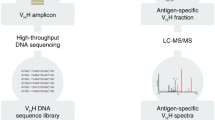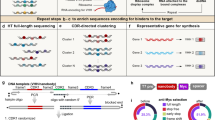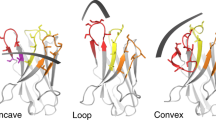Abstract
Single-domain antigen-binding fragments of camelid antibodies, known as VHHs or nanobodies, are widely used affinity reagents. However, their production involving animal immunization is time- and resource-intensive. Starting from a sequence dataset of llama VHHs, we designed a novel scaffold, based on conserved framework sequences, suitable for bacterial nanobody expression and synthetic library construction. The consensus scaffold was validated by grafting the CDRs from two known nanobodies. While maintaining their binding properties, the two chimeric nanobodies showed higher levels of expression and solubility in E. coli when compared to the corresponding wild types. A proof-of-concept synthetic combinatorial library, suitable for ribosome display (RD) selection, was obtained by encoding three randomized complementarity determining regions within the consensus framework. The library, made of linear DNA fragments, has an estimated complexity of > 1012 that is three orders of magnitude higher than common phage display libraries. The bacterial expression of several library clones showed a high production of soluble recombinant proteins. The high complexity of the library, confirmed by sequencing of a subset of clones, as well as a preliminary RD selection of a maltose binding protein binder, indicated this approach as a starting point in the construction of synthetic combinatorial libraries to be used as animal-free tools for the low-cost selection of target-specific nanobodies.





Similar content being viewed by others
References
Hamers-Casterman, C., Atarhouch, T., Muyldermans, S., Robinson, G., Hammers, C., Songa, E. B., et al. (1993). Naturally occurring antibodies devoid of light chains. Nature,363(6428), 446–448. https://doi.org/10.1038/363446a0.
Oliveira, S., Heukers, R., Sornkom, J., Kok, R. J., & Van Bergen En Henegouwen, P. M. P. (2013). Targeting tumors with nanobodies for cancer imaging and therapy. Journal of Controlled Release. https://doi.org/10.1016/j.jconrel.2013.08.298.
Smolarek, D., Bertrand, O., & Czerwinski, M. (2012). Variable fragments of heavy chain antibodies (VHHs): A new magic bullet molecule of medicine? Postepy Higieny i Medycyny Doswiadczalnej,66, 348–358. https://doi.org/10.5604/17322693.1000334.
Muyldermans, S., Baral, T. N., Retamozzo, V. C., De Baetselier, P., De Genst, E., Kinne, J., et al. (2009). Camelid immunoglobulins and nanobody technology. Veterinary Immunology and Immunopathology. https://doi.org/10.1016/j.vetimm.2008.10.299.
Harmsen, M. M., & De Haard, H. J. (2007). Properties, production, and applications of camelid single-domain antibody fragments. Applied Microbiology and Biotechnology. https://doi.org/10.1007/s00253-007-1142-2.
Lauwereys, M., Ghahroudi, M. A., Desmyter, A., Genst, E. De, Wyns, L., & Muyldermans, S. (1998). Potent enzyme inhibitors derived from dromedary heavy-chain antibodies. Early Intervention in Psychiatry,17(13), 3512–3520.
De Genst, E., Silence, K., Decanniere, K., Conrath, K., Loris, R., Kinne, J., et al. (2006). Molecular basis for the preferential cleft recognition by dromedary heavy-chain antibodies. Proceedings of the National Academy of Sciences,103(12), 4586–4591. https://doi.org/10.1073/pnas.0505379103.
Chakravarty, R., Goel, S., & Cai, W. (2014). Nanobody: The “magic bullet” for molecular imaging? Theranostics. https://doi.org/10.7150/thno.8006.
Hassanzadeh-Ghassabeh, G., Devoogdt, N., De Pauw, P., Vincke, C., & Muyldermans, S. (2013). Nanobodies and their potential applications. Nanomedicine. https://doi.org/10.2217/nnm.13.86.
De Meyer, T., Muyldermans, S., & Depicker, A. (2014). Nanobody-based products as research and diagnostic tools. Trends in Biotechnology. https://doi.org/10.1016/j.tibtech.2014.03.001.
Desmyter, A., Spinelli, S., Roussel, A., & Cambillau, C. (2015). Camelid nanobodies: Killing two birds with one stone. Current Opinion in Structural Biology,32, 1–8. https://doi.org/10.1016/j.sbi.2015.01.001.
Olichon, A., & De Marco, A. (2012). Preparation of a naïve library of camelid single domain antibodies. Methods in Molecular Biology. https://doi.org/10.1007/978-1-61779-968-6_5.
Pardon, E., Laeremans, T., Triest, S., Rasmussen, S. G. F., Wohlkönig, A., Ruf, A., et al. (2014). A general protocol for the generation of Nanobodies for structural biology. Nature Protocols. https://doi.org/10.1038/nprot.2014.039.
Verheesen, P., Roussis, A., de Haard, H. J., Groot, A. J., Stam, J. C., den Dunnen, J. T., et al. (2006). Reliable and controllable antibody fragment selections from Camelid non-immune libraries for target validation. Biochimica et Biophysica Acta - Proteins and Proteomics. https://doi.org/10.1016/j.bbapap.2006.05.011.
Monegal, A., Ami, D., Martinelli, C., Huang, H., Aliprandi, M., Capasso, P., et al. (2009). Immunological applications of single-domain llama recombinant antibodies isolated from a naïve library. Protein Engineering, Design & Selection. https://doi.org/10.1093/protein/gzp002.
Kehoe, J. W., & Kay, B. K. (2005). Filamentous phage display in the new millennium. Chemical Reviews. https://doi.org/10.1021/cr000261r.
Moutel, S., Bery, N., Bernard, V., Keller, L., Lemesre, E., De Marco, A., et al. (2016). NaLi-H1: A universal synthetic library of humanized nanobodies providing highly functional antibodies and intrabodies. eLife,5, 1–31. https://doi.org/10.7554/eLife.16228.
McMahon, C., Baier, A. S., Pascolutti, R., Wegrecki, M., Zheng, S., Ong, J. X., et al. (2018). Yeast surface display platform for rapid discovery of conformationally selective nanobodies. Nature Structural & Molecular Biology,25(3), 289–296. https://doi.org/10.1038/s41594-018-0028-6.
Koide, A., Tereshko, V., Uysal, S., Margalef, K., Kossiakoff, A. A., & Koide, S. (2007). Exploring the capacity of minimalist protein interfaces: Interface energetics and affinity maturation to picomolar KD of a single-domain antibody with a flat paratope. Journal of Molecular Biology. https://doi.org/10.1016/j.jmb.2007.08.027.
Plückthun, A. (2012). Ribosome display: A perspective. Methods in Molecular Biology. https://doi.org/10.1007/978-1-61779-379-0_1.
Yau, K. Y. F., Groves, M. A. T., Li, S., Sheedy, C., Lee, H., Tanha, J., et al. (2003). Selection of hapten-specific single-domain antibodies from a non-immunized llama ribosome display library. Journal of Immunological Methods,281(1–2), 161–175. https://doi.org/10.1016/j.jim.2003.07.011.
Li, R., Kang, G., Hu, M., & Huang, H. (2019). Ribosome display: A potent display technology used for selecting and evolving specific binders with desired properties. Molecular Biotechnology,61(1), 60–71. https://doi.org/10.1007/s12033-018-0133-0.
Schaffitzel, C., Hanes, J., Jermutus, L., & Plückthun, A. (1999). Ribosome display: An in vitro method for selection and evolution of antibodies from libraries. Journal of Immunological Methods. https://doi.org/10.1016/S0022-1759(99)00149-0.
Sambrook, J., & W Russell, D. (2001). Molecular cloning: A laboratory manual. Cold Spring Harbor, NY: Cold Spring Harbor Laboratory Press.
Gorlani, A., Adams, H., Hermans, P., & Verrips, T. (2011). Antibody engineering reveals the important role of J segments in the production efficiency of llama single-domain antibodies in Saccharomyces cerevisiae. Protein Engineering, Design & Selection. https://doi.org/10.1093/protein/gzr057.
Crameri, A., Whitehorn, E. A., Tate, E., & Stemmer, W. P. C. (1996). Improved green fluorescent protein by molecular evolution using DNA shuffling. Nature Biotechnology. https://doi.org/10.1038/nbt0396-315.
Amstutz, P., Binz, H. K., Parizek, P., Stumpp, M. T., Kohl, A., Grütter, M. G., et al. (2005). Intracellular kinase inhibitors selected from combinatorial libraries of designed ankyrin repeat proteins. Journal of Biological Chemistry. https://doi.org/10.1074/jbc.M501746200.
Hanes, J., & Plückthun, A. (1997). In vitro selection and evolution of functional proteins by using ribosome display. Proceedings of the National academy of Sciences of the United States of America. https://doi.org/10.1073/pnas.94.10.4937.
Huber, T., Steiner, D., Röthlisberger, D., & Plückthun, A. (2007). In vitro selection and characterization of DARPins and Fab fragments for the co-crystallization of membrane proteins: The Na + -citrate symporter CitS as an example. Journal of Structural Biology. https://doi.org/10.1016/j.jsb.2007.01.013.
Zahnd, C., Amstutz, P., & Plückthun, A. (2007). Ribosome display: Selecting and evolving proteins in vitro that specifically bind to a target. Nature Methods. https://doi.org/10.1038/nmeth1003.
Milovnik, P., Ferrari, D., Sarkar, C. A., & Plückthun, A. (2009). Selection and characterization of DARPins specific for the neurotensin receptor 1. Protein Engineering, Design & Selection,22(6), 357–366. https://doi.org/10.1093/protein/gzp011.
Sehr, P., Zumbach, K., & Pawlita, M. (2001). A generic capture ELISA for recombinant proteins fused to glutathione S-transferase: Validation for HPV serology. Journal of Immunological Methods,253(1–2), 153–162. https://doi.org/10.1016/S0022-1759(01)00376-3.
Muyldermans, S. (2013). Nanobodies: Natural single-domain antibodies. Annual Review of Biochemistry. https://doi.org/10.1146/annurev-biochem-063011-092449.
Kirchhofer, A., Helma, J., Schmidthals, K., Frauer, C., Cui, S., Karcher, A., et al. (2010). Modulation of protein properties in living cells using nanobodies. Nature Structural & Molecular Biology. https://doi.org/10.1038/nsmb.1727.
Vincke, C., Loris, R., Saerens, D., Martinez-Rodriguez, S., Muyldermans, S., & Conrath, K. (2009). General strategy to humanize a camelid single-domain antibody and identification of a universal humanized nanobody scaffold. Journal of Biological Chemistry,284(5), 3273–3284. https://doi.org/10.1074/jbc.M806889200.
Liu, J. L., Goldman, E. R., Zabetakis, D., Walper, S. A., Turner, K. B., Shriver-Lake, L. C., et al. (2015). Enhanced production of a single domain antibody with an engineered stabilizing extra disulfide bond. Microbial Cell Factories. https://doi.org/10.1186/s12934-015-0340-3.
Harmsen, M. M., Ruuls, R. C., Nijman, I. J., Niewold, T. A., Frenken, L., & Geus, D. (2001). Llama heavy chain V-regions consist of at least four distinct subfamilies revealing novel sequence features. Molecular Immunology,37(2000), 579–590.
Saerens, D., Pellis, M., Loris, R., Pardon, E., Dumoulin, M., Matagne, A., et al. (2005). Identification of a universal VHH framework to graft non-canonical antigen-binding loops of camel single-domain antibodies. Journal of Molecular Biology,352(3), 597–607. https://doi.org/10.1016/j.jmb.2005.07.038.
Mitchell, L. S., & Colwell, L. J. (2018). Analysis of nanobody paratopes reveals greater diversity than classical antibodies. Protein Engineering, Design & Selection. https://doi.org/10.1093/protein/gzy017.
Yan, J., Li, G., Hu, Y., Ou, W., & Wan, Y. (2014). Construction of a synthetic phage-displayed Nanobody library with CDR3 regions randomized by trinucleotide cassettes for diagnostic applications. Journal of Translational Medicine. https://doi.org/10.1186/s12967-014-0343-6.
Yang, H. Y., Kang, K. J., Chung, J. E., & Shim, H. (2009). Construction of a large synthetic human scFv library with six diversified CDRs and high functional diversity. Molecules and Cells. https://doi.org/10.1007/s10059-009-0028-9.
Virnekas, B., Ge, L., Plukthun, A., Schneider, K. C., Wellnhofer, G., & Moroney, S. E. (1994). Trinucleotide phosphoramidites: Ideal reagents for the synthesis of mixed oligonucleotides for random mutagenesis. Nucleic Acids Research. https://doi.org/10.1093/nar/22.25.5600.
Acknowledgement
V.G. is the recipient of a PhD student fellowship from the Fondazione Cariparma. This work was supported in part by a grant from Regione Emilia-Romagna, Italy (Programma di Ricerca Regione-Università 2010-2012; PRUa1RI-2012-006). Support from the Interuniversity Consortium for Biotechnologies (CIB) and European Molecular Biology Organization (EMBO) is also gratefully acknowledged.
Funding
This work has benefited from the equipment and framework of the COMP-HUB Initiative, funded by the ‘Departments of Excellence’ program of the Italian Ministry for Education, University, and Research (MIUR, 2018-2022).
Author information
Authors and Affiliations
Corresponding author
Ethics declarations
Conflict of interest
The authors declare no financial or commercial conflict of interest.
Additional information
Publisher's Note
Springer Nature remains neutral with regard to jurisdictional claims in published maps and institutional affiliations.
Electronic supplementary material
Below is the link to the electronic supplementary material.
Rights and permissions
About this article
Cite this article
Ferrari, D., Garrapa, V., Locatelli, M. et al. A Novel Nanobody Scaffold Optimized for Bacterial Expression and Suitable for the Construction of Ribosome Display Libraries. Mol Biotechnol 62, 43–55 (2020). https://doi.org/10.1007/s12033-019-00224-z
Published:
Issue Date:
DOI: https://doi.org/10.1007/s12033-019-00224-z




